The Complex Art of Cambodian Ikat
Upon arriving in the Cambodian city of Phnom Penh for a week-long school service trip 2016, I had no idea that I was also beginning a journey into the world of traditional Cambodian textiles. My trip was mainly focused on working with a local non-profit organization, but I ended up having the unique opportunity to begin learning about the beautiful and skilled practice of Cambodian, or Khmer, ikat weaving.
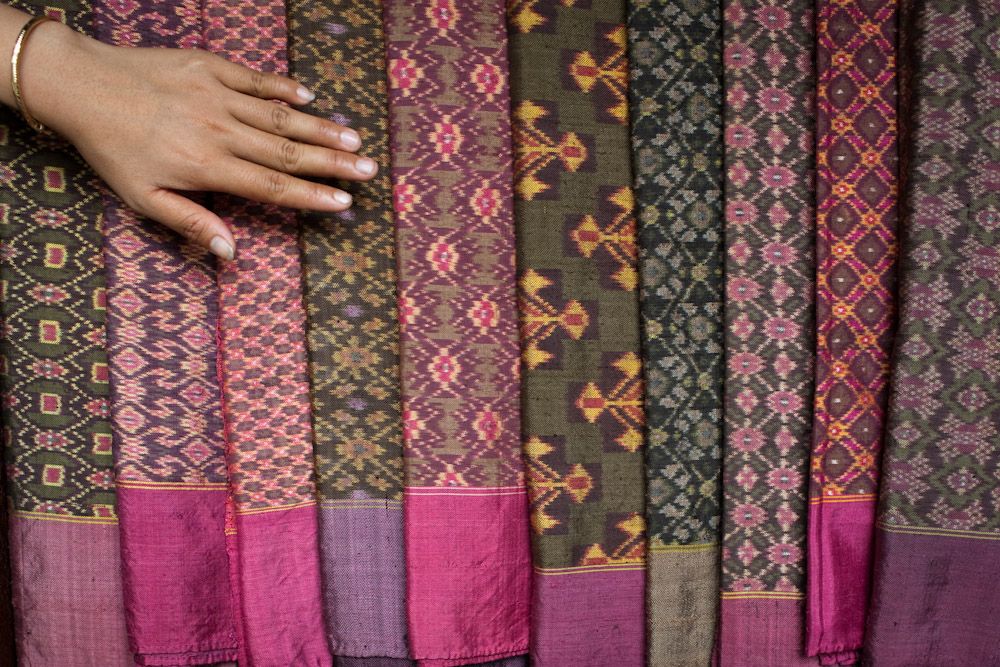
The term ikat refers to a textile design process in which threads are dyed before being woven together to create beautiful intricate patterns. While my first exposure to ikat was in Cambodia, it is believed that this weaving practice developed in multiple regions around the world at the same time, meaning that the development of ikat may not be tied to one specific culture.
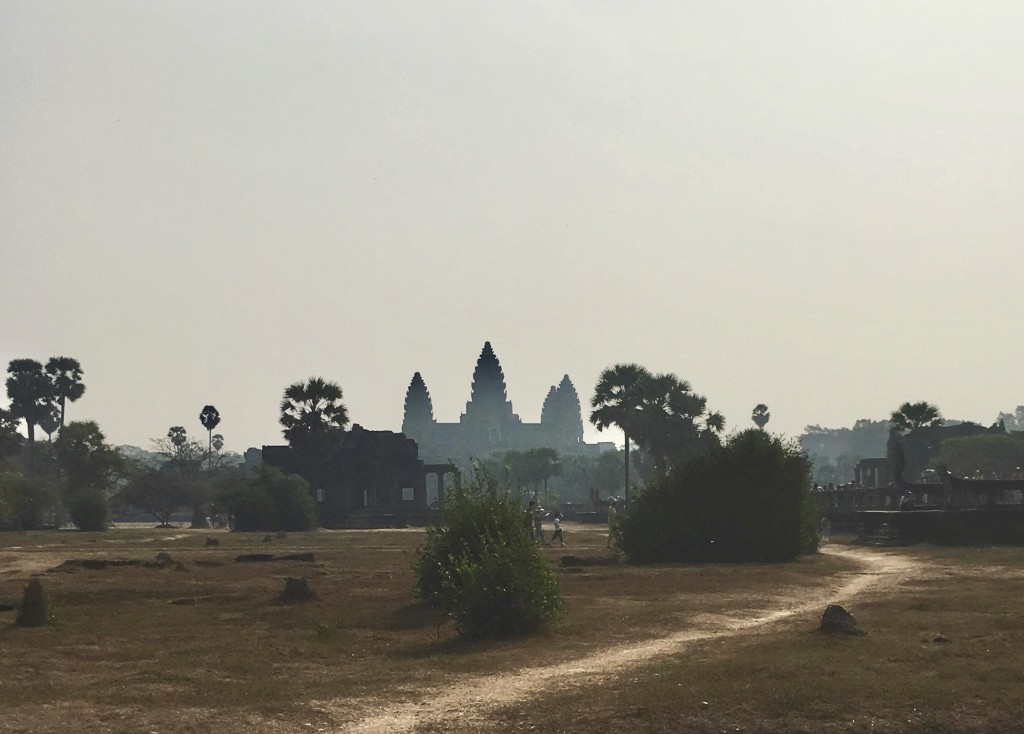
In Cambodia, the practice of ikat dates back to the Angkor Dynasty, and is uniquely tied to Cambodian textile and cultural tradition. In fact, in the famous Cambodian temple complex, Angkor Wat, you can find a series of motifs on the temple walls featuring garments with traditional Khmer ikat designs.
From initial stages of dyeing threads to final phases of weaving, Khmer ikat requires careful planning and skillful preparation. The process begins with the meticulous spinning of silk fibers into delicate spools of thread. Each silk thread is then deliberately colored by tying sections of the thread and immersing the thread in dye to create a resist pattern that corresponds with the final design. Khmer ikat is a form of weft ikat, where only the weft threads are dyed to form the textile’s pattern. Throughout the weaving process, the weft threads are adjusted and realigned to ensure that the pattern becomes visible.
Tying and Weaving the Thread
Khmer ikat’s uniqueness is derived from its use of materials that are native to the Cambodian landscape. For example, traditional Khmer ikat uses golden silk which is spun from the fibers of the indigenous golden silkworm, and a variety of natural dye pigments are extracted from native species such as the lac insect and the prohut tree.
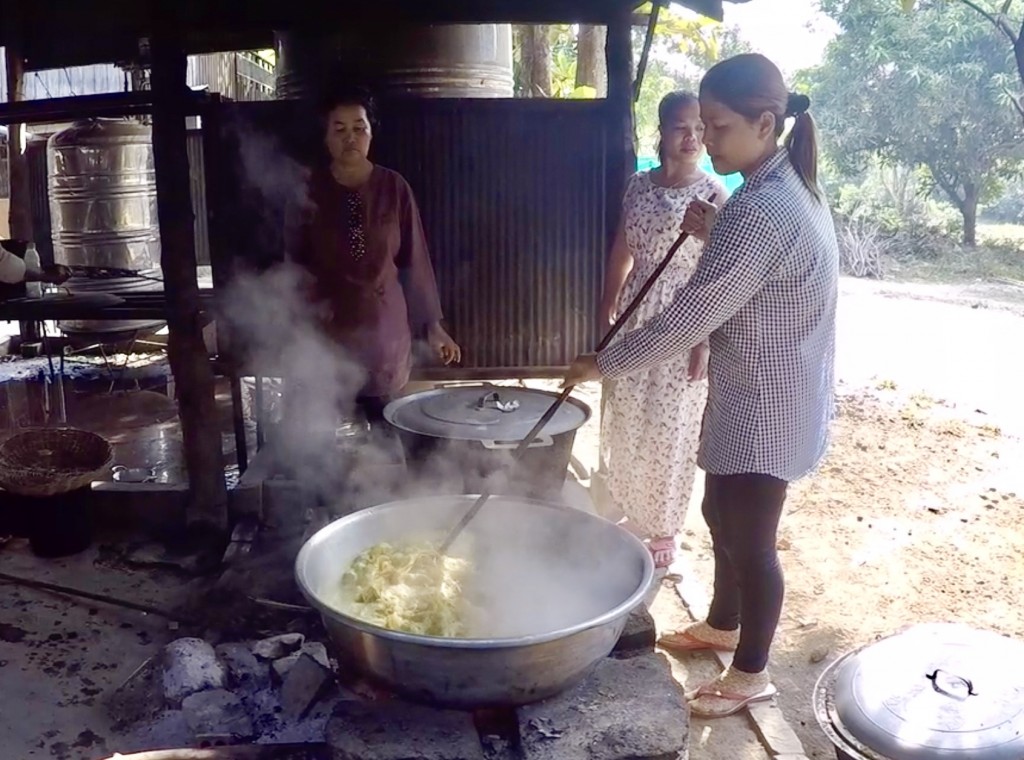
In recent history, the materials and techniques used in the production of Khmer ikat have evolved as a result of changing consumer demands and resources available to weavers. For example, importing white silkworms has become a common alternative to the native golden silkworm. The issue with this shift is that because white silkworms are not native to Cambodia, they are more difficult to farm. Likewise, with the increased use of synthetic materials throughout textile production processes, many artists are moving away from using silk altogether.
The Khmer weaving tradition has also suffered due to the channels used to sell textiles. Many weavers sell their works through middlemen, who supply them with silk, and sell the finished products to retailers. Oftentimes, even the most highly skilled weavers are paid extremely low wages. Due to a growing number of tourists visiting Cambodia, the demand for inexpensive traditional craft souvenirs has increased, forcing weavers to produce as many finished pieces as possible. This system has caused weavers to shift away from prioritizing high quality textile production to focusing on producing higher quantities of textiles. As a result, weavers have had to simplify their designs in order to sustain their careers.
Khmer ikat was also affected by the devastating results of the Khmer Rouge regime. The Khmer Rouge, led by Pol Pot starting in 1975, aimed to remake Cambodia into a “communist-style, agricultural utopia”. As a result of these policies, many people were moved to rural areas and required to work on farms in unsafe conditions. The Khmer Rouge executed people who were considered enemies of the regime, which included intellectuals and potential leaders. Approximately 1.7 to 2.2 million Cambodians died during the rule of the Khmer Rouge. While Pol Pot was removed from power in 1979, the regime left a devastating impact upon Cambodia which has affected the country to this day.
The Khmer Rouge also instituted a ban against the production of decorative fabrics and destroyed silk looms and intricate fabrics as they were seen as a sign of elite status. Causing further devastation, the Khmer Rouge burned down patches of mulberry trees to create space for rice paddies. Mulberry trees are the natural food source for the golden silkworm, so with their destruction, the golden silkworm, which is used for traditional Khmer ikat, became less available.
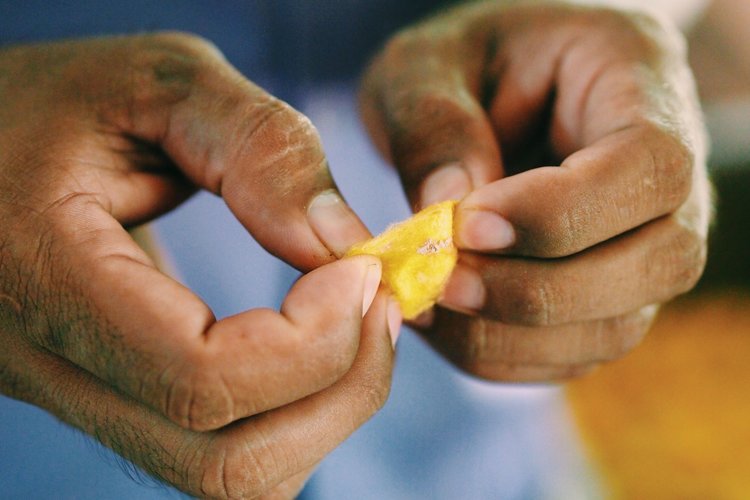
Many of the traditional Cambodian ikat patterns were only passed down from generation to generation by word-of-mouth. If newer generations did not begin the practice of ikat weaving themselves, the designs passed down over generations would be lost. Unfortunately, this was the case with many Cambodian ikat designs.
While Khmer ikat has suffered many setbacks in recent history, individuals and organizations devoted to cultural preservation are working to restore this important Cambodian tradition. When I traveled to Cambodia in 2016, I was fortunate enough to visit IKTT (Institute of Khmer Traditional Textiles), one of the groups working to revitalize the presence of ikat traditions in Cambodia. Founded by Kikuo Morimoto in 1996, IKTT is focused on re-establishing the prominence of traditional Khmer ikat dyeing and weaving practice.
Two years earlier in 1994, Morimoto traveled to a village where he met a few older craftswomen who had knowledge of traditional silk weaving processes. In meeting them, Morimoto realized that it was quite possible that their knowledge would disappear within the next few years unless it became someone’s priority. This inspired Morimoto to begin working on a project to protect the disappearing art of traditional Cambodian ikat. With the support of the Japanese government, he opened a small weaving studio in the city of Siem Reap to work toward this vision.
IKTT has developed a village dedicated to the creation of ikat in the traditional Khmer style. IKTT has worked to reforest the area, focusing on species that can be used for traditional dyeing techniques. For example, they grow trees that lac insects live in and cultivate golden silkworms. IKTT has also trained many artisans who live and work in the village, in order to create high-quality Khmer ikat.
Check out this video for more information about Mr. Morimoto’s vision for IKTT.
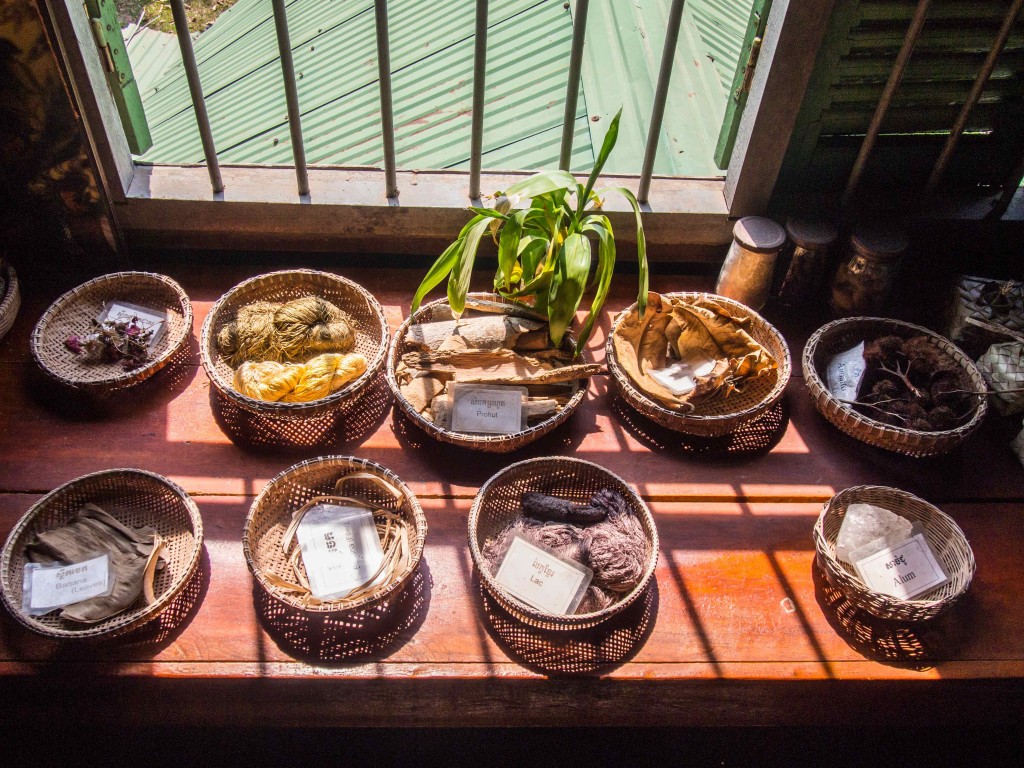
IKTT’s village is always filled with life. The buildings that make up the village are enveloped in lush groves, the bright green space dotted with an occasional brightly colored flower. The workshops buzz with energy, each of the craftspeople work diligently on a task. Just outside the workshop, a group of women use the pungent bark of the prohut tree to produce a rich yellow-colored dye. A few artisans sit at the large looms that fill much of the space in the workshop, and with great skill and focus, they slowly reveal the detailed design created by the carefully dyed silk threads.
The process of creating traditional Khmer ikat at IKTT begins with silk thread production. The silk is first collected from the golden silkworms cultivated on-site. First, the golden cocoons are boiled and the raw silk is collected from the outer part of the cocoon. Afterwards, the fine silk in the inner part of the cocoon in extracted in the same manner. Once the silk has been separated from the cocoon, it is processed into usable thread.
With careful planning, artists can use a simple color palette of yellow, red, green, blue, and black to develop a rich variety of colors that add depth and dimension to the piece.
At IKTT, the craftspeople use banana fiber to tie the threads and create a resist pattern for dyeing. The banana fiber is waterproof which allows it to stand up to the multiple dyeing processes needed to create the intricate ikat designs. With careful planning, artists can use a simple color palette of yellow, red, green, blue, and black to develop a rich variety of colors that add depth and dimension to the piece.
The artisans at IKTT utilize traditional designs that have been passed down for generations. Typically, they do not use sketches to plan the design, instead, they use their knowledge of past designs to guide the development of the new piece.
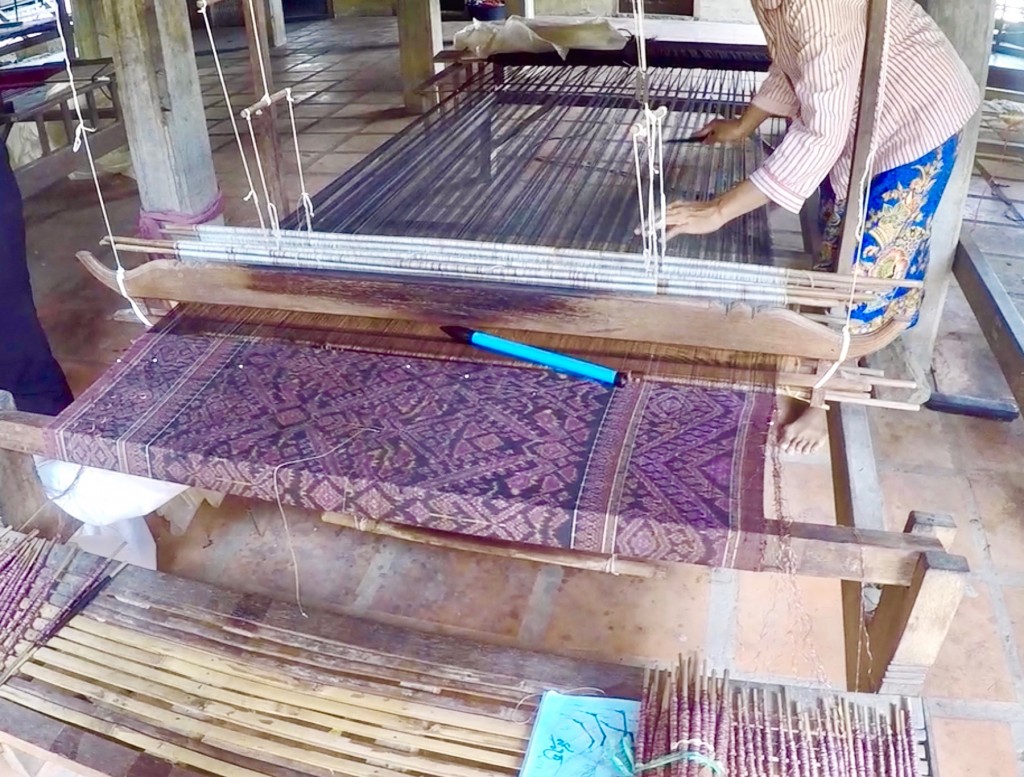
Once the threads are dyed, they are woven together on a loom, revealing the intricate pattern. This process is typically very time consuming, and at IKTT many craftspeople are involved in the process of weaving the final piece. However, the painstaking process produces truly amazing results. Final pieces of Khmer ikat are intricate and exquisitely designed, highlighting the artists' skill and dedication to the practice.
Final pieces of Khmer ikat are intricate and exquisitely designed, highlighting the artists' skill and dedication to the practice.
Despite a series of threatening factors, Khmer ikat tradition has managed to survive through the efforts of many dedicated artists and craftspeople. The revival of a traditional art form is an important element of maintaining a historical record of important cultural traditions. With the help of organizations like IKTT, perhaps Khmer ikat can act as a valuable resource for promoting and preserving Cambodian traditions.
For updates on IKTT’s current projects follow @iktt_official on Instagram.
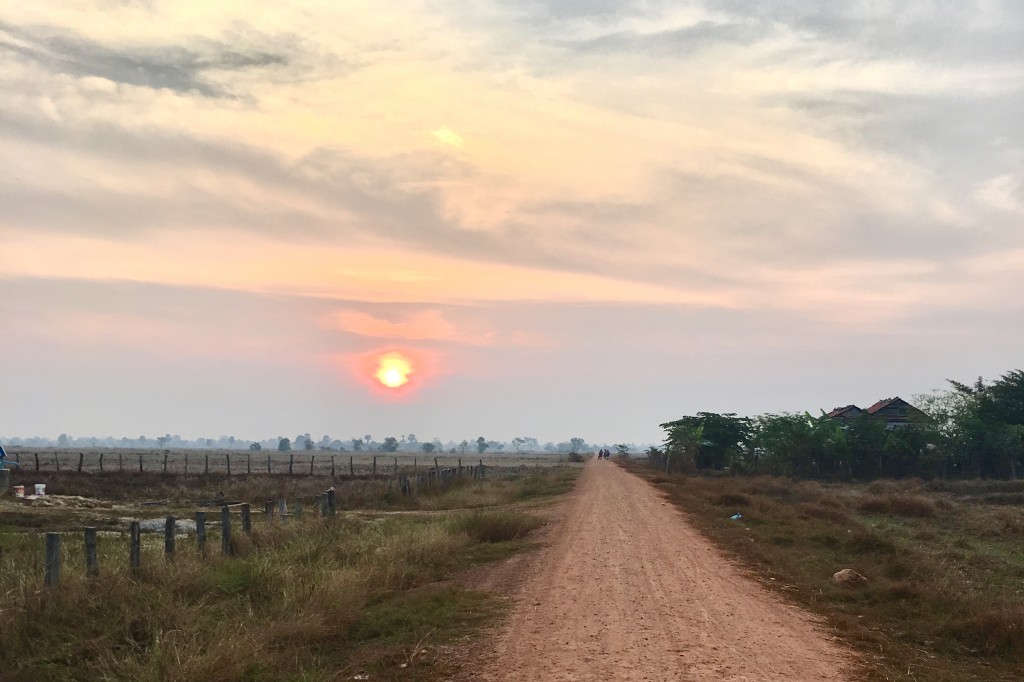
If you’re interested in learning how to create your own ikat, Textile Arts Center will be hosting a special six-week ikat class in Manhattan, starting on February 12th, 2020. Students will craft their own unique ikat piece, learning resist dyeing techniques and refining their weaving skills.
Click here to sign up for TAC's ikat class
Bibliography
Harbarger, Molly. “Silk Dyer Morimoto Kikuo Resurrecting a Cultural Ecology.” Kyoto Journal, link.
“Institute of Khmer Traditional Textiles.” link
“Khmer Rouge.” History.com, A&E Television Networks, Sept. 2017, link.
Lush, Emily. Making of: Golden Silk, Cambodia. The Textile Atlas, Jan. 2018, link.
Morimoto, Kikuo. “Traces of War: The Revival of Silk Weaving in Cambodia.” 2002, link.
Reif, Rita. Restoring a Fine Khmer Craft Rent by Revolution. The New York Times, 22 June 1997, link.
Taguchi, Emily. “Interview With Kikuo Morimoto.” PBS, Public Broadcasting Service, 2007, link.